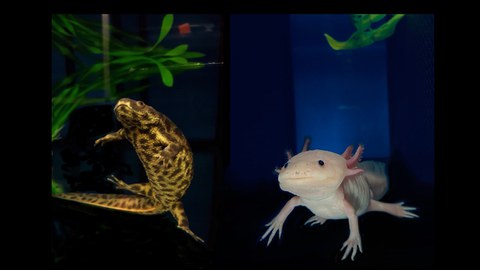Aug 25, 2021
CRTD hosted the international forum on salamander models in research

Newt and axolotl - salamanders that researchers study to understand the process of regeneration better.
Researchers from the Center for Regenerative Therapies Dresden (CRTD) at the TU Dresden hosted the biannual “Salamander models in cross-disciplinary biological research” forum. The online meeting offered a space for stimulating discussions for over 200 researchers from all over the world.
“Salamander models in cross-disciplinary biological research” online forum brought together experts in diverse fields, including development, evolution, ecology, immunology, and regenerative biology. All with the aim of expanding the understanding of the salamander models, promoting salamander research, and stimulating discussion, cooperation, and distribution of resources within this research community.
“Salamanders are exceptional organisms because of their outstanding ability to regenerate large parts of their bodies,” says Maximina Yun, research group leader at the CRTD and Max Planck Institute of Molecular Cell Biology and Genetics (MPI-CBG) in Dresden and one of the organizers of the event. “Evolutionarily, salamanders are the closest animals to humans, capable of such complex regeneration. This is why they became a sought-after research model, used to characterize the regeneration process and to discover its underlying mechanisms.”
Starting on August 16th, the three-day online meeting offered a great opportunity to discuss the latest results across the many fields that focus their research on salamanders. The first day was filled with talks covering different aspects of regenerative biology. A keynote lecture was given by Prof. Elly Tanaka, former director of the CRTD, now research group leader at the Research Institute of Molecular Pathology (IMP) in Vienna.
The second day offered a variety of topics, from regeneration through immunology, pathogenesis, and emerging salamander models. At the end of each day scientists joined an online poster session that offered the possibility to discuss research results in smaller groups.
The final day of the forum was dedicated to workshops. Prayag Murawala, research group leader at the Mount Desert Island (MDI) Biological Laboratory presented the most commonly used transgenic methods used in salamander research. Sergej Nowoshilow from the Global Computational Biology and Digital Sciences section of the Boehringer Ingelheim Regional Center Vienna (RCV) gave an overview of the available genomic resources for Next-Generation Sequencing analyses.
“This meeting was a wonderful opportunity to gather top scientists from different fields of salamander research, and also a rare opportunity to reunite with some of the CRTD alumni that are now spread all over the world,“ says Tatiana Sandoval-Guzmán, research group leader at the CRTD and one of the organizers of the forum. ”We would like to thank all the sponsors of the event: the German Research Foundation (DFG), the CRTD and the TU Dresden, as well as the Company of Biologists. The sponsoring made it possible for more students and technicians to join the forum. We are grateful for all the support because it let us make the meeting a really unique experience for all the participants.”
